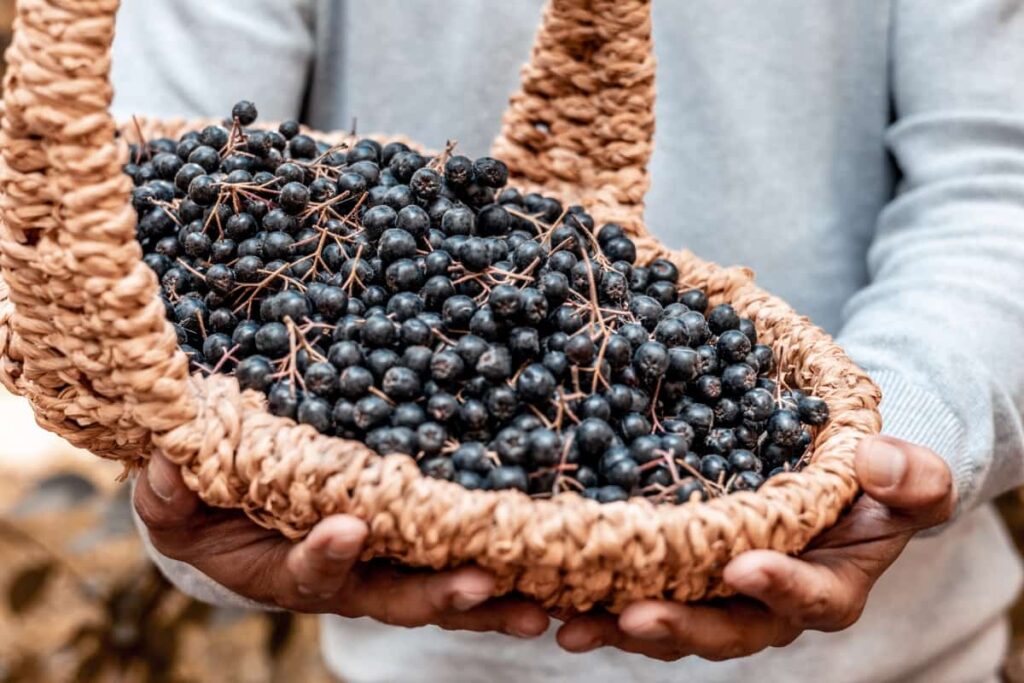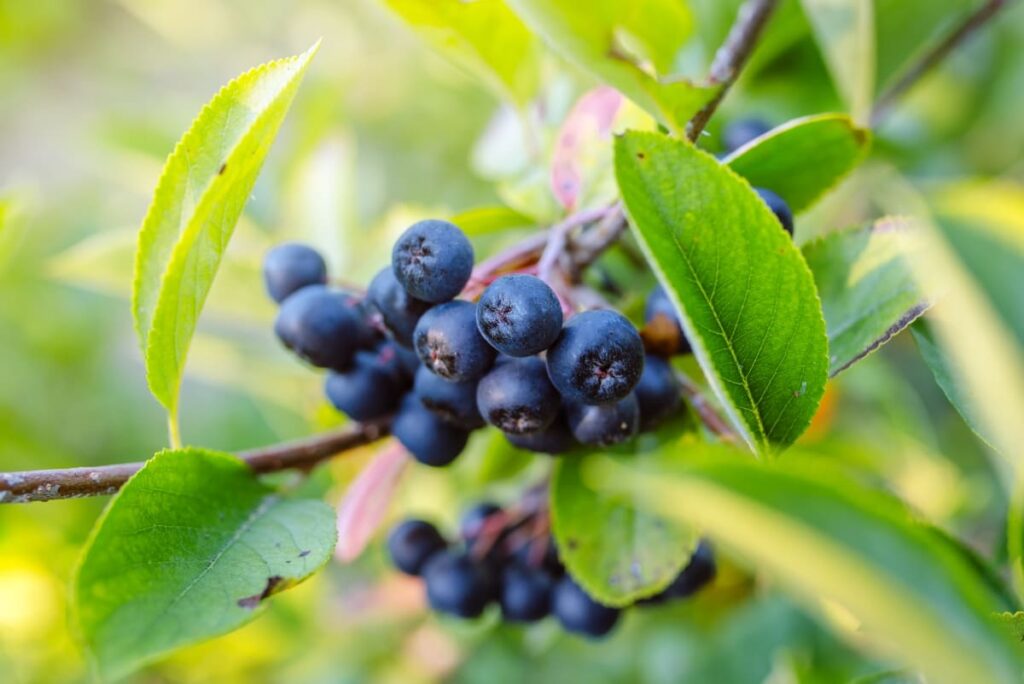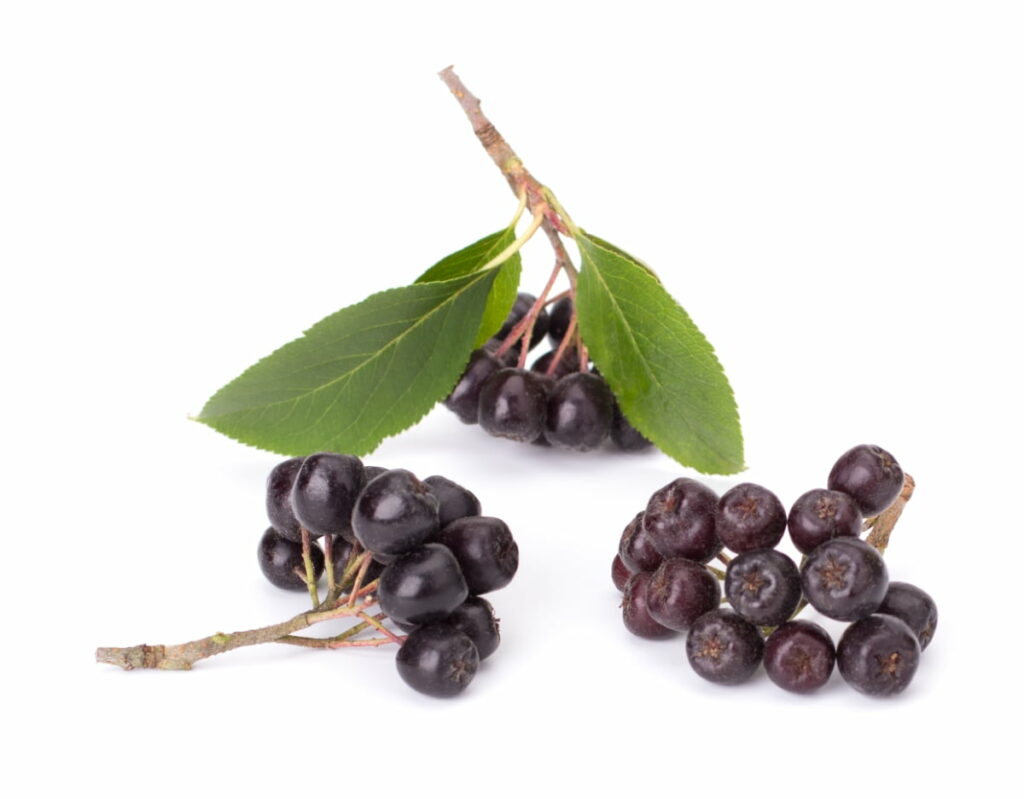- Chokeberries, also called Aronia berries, are native to North America.
- They can grow well in a wide range of climates and soil types, making them adaptable to many regions.
- Chokeberries are small, round fruits that typically measure around 0.2–0.6 inches (5–15 mm) in diameter.
- They can be black, red, or purple, depending on the species.
- Chokeberries are known for their tart flavor, which can be quite intense.
Benefits and Uses Chokeberries
Chokeberries are rich in antioxidants and vitamins, making them a popular choice for health-conscious consumers. They can be consumed fresh, dried, or processed into juices, jams, and supplements. Additionally, chokeberries are valued in landscaping for their attractive foliage and clusters of white flowers.

How to Grow Chokeberries
Propagation Methods
Seed Propagation
Chokeberries can be propagated from seeds, which require stratification for germination. Collect ripe berries, remove pulp, and air dry seeds. Stratify seeds in moist sand or peat moss in the refrigerator for 2-3 months. Plant in well-draining soil in early spring.
Cuttings and Division
As one of the Chokeberry propagation techniques, cuttings involve taking semi-hardwood cuttings in late spring or early summer. Remove leaves from the cutting’s lower portion and dip them in the rooting hormone. Plant the cutting in a sand and peat moss mixture. Division of mature plants can also be done in early spring, separating the rhizomes and replanting.
Choosing the Right Location
Soil Requirements
Chokeberries thrive in well-drained, slightly acidic soil with a pH of 5.8 to 6.5. Amending soil with organic matter like compost enhances fertility and drainage.
Sunlight and Shade Considerations
Chokeberries prefer full sun but tolerate partial shade. Select a location with at least 6 hours of sunlight for optimal growth and fruit production. However, they can still thrive in shadier spots, though fruit production may be reduced.
Planting Aronia Berries
Best Time to Plant
Select early spring or late fall for planting. Avoid extreme temperatures to foster healthy root development in aronia berry cultivation.
Step-By-Step Planting Guide
- Choose a well-lit area with well-drained soil for planting Aronia berries.
- Prepare the soil by clearing the weeds and adding organic matter.
- With a garden shovel, dig a hole as wide and deep as the root ball.
- Place the chokeberry plant in the hole. Ensure the top of the root ball is level with the soil surface.
- The hole should be backfilled with soil and firmed gently around the plant.
- Water thoroughly and apply mulch to retain moisture and suppress weeds.
- Monitor moisture levels and provide regular watering as needed.
Watering and Mulching
Watering Requirements
Chokeberries require consistent moisture, particularly during their establishment phase. In hot or dry climates, frequent watering may be necessary, while in cooler or humid conditions, less frequent watering may suffice. Monitor soil moisture and adjust watering frequency accordingly.
Benefits of Mulching
Mulch retains soil moisture by reducing evaporation, thus minimizing the need for frequent watering. It regulates soil temperature, keeping it cooler in summer and warmer in winter, which promotes optimal growth. Mulch also suppresses weed growth, conserves soil nutrients, and enhances soil structure, fostering a healthy root environment for chokeberry plants.
In case you missed it: Vertical Strawberry Farming: A New Way to Increase Your Income and Yield

Fertilization and Soil Management
When and How to Fertilize
Aronia berry fertilization should be done in early spring before new growth emerges. Apply a balanced (like 10-10-10), slow-release fertilizer, avoiding high-nitrogen formulations that can promote excessive foliage growth at the expense of fruit production. Evenly spread the fertilizer around the plant’s base and water thoroughly to facilitate absorption.
Soil pH and Nutrient Balance
Maintaining a slightly acidic soil pH between 5.8 and 6.5 is crucial for chokeberry health and productivity. Organic matter, such as vermicompost or aged manure, can improve soil structure and nutrient retention while maintaining the desired pH balance for optimal chokeberry growth.
Pruning and Maintenance
Pruning Techniques
- Pruning Chokeberry plants involves trimming dead or damaged branches during dormancy to encourage new growth.
- Remove crowded or weak stems to enhance airflow and sunlight penetration.
- Cut oldest stems to ground level every few years to stimulate vigorous new growth.
Seasonal Maintenance Tips
- Spring: Fertilize with a balanced formula and mulch to retain moisture.
- Summer: Water regularly, especially during dry spells, and monitor for pests and diseases.
- Fall: Harvest ripe berries and apply a layer of compost around the base.
- Winter: Protect young plants from frost with a layer of mulch.
Pest and Disease Control
Common Pests and Diseases
Chokeberries have less susceptibility to plant diseases and only little problems with pests. Common insect pests are the prairie tent caterpillar, eastern tent caterpillar, and aphids. In the northeastern United States, chokecherry is a primary host of the eastern tent caterpillar. Chokecherry is susceptible to X-disease, black knot, stem decay, shothole, Valsa canker, and honey fungus.
Organic and Chemical Control Options
For organic Chokeberry pest control, introduce beneficial insects like ladybugs and lacewings to manage aphids and mites. Additionally, neem oil or insecticidal soap can help control pest infestations. To prevent fungal diseases, ensure proper air circulation and avoid overhead watering. Chemical options include fungicides and insecticides, but use them sparingly and follow label instructions carefully.
Harvesting Aronia Berries
Signs of Ripeness
Aronia berries typically reach peak ripeness in late summer to early fall, around August to September, depending on the region. Look for berries that are in deep purple to black, indicating full ripeness. They should feel plump and firm to the touch, with a slight give when gently squeezed. Avoid berries that are still red or green, as they are not fully matured and may be tart or astringent in taste.
Harvesting Techniques
For harvesting Aronia berries, use scissors or small pruning shears to snip clusters of ripe berries from the plant, leaving the stems intact. Alternatively, gently handpick individual berries from the cluster. Be careful not to crush or bruise the berries during harvest, as this can affect their quality. Place harvested berries in a shallow container to prevent crushing and bruising, and avoid stacking them too deeply to prevent squishing. Rinse berries gently under cold water before using or storing them. Harvesting in the early morning or late afternoon when temperatures are cooler can help preserve the berries’ freshness.
In case you missed it: How to Start Blueberry Farming in India: Varieties, Yield, Cost, and Profit Per Acre

Winter Care for Chokeberries
Preparing for Winter
Before winter sets in, it’s crucial to ensure chokeberry plants are adequately prepared. This includes proper pruning to remove dead or diseased branches, which can prevent potential damage from heavy snow or ice accumulation. Also, providing a layer of mulch around the plant’s base can help insulate the roots and retain moisture during the colder months. Adequate hydration before winter dormancy is also essential for plant health and resilience.
Frost Protection Strategies
Covering plants with frost cloths or blankets during cold snaps can shield them from freezing temperatures and frostbite. Also, watering the plants thoroughly before an expected frost can help insulate them, as moist soil retains more heat than dry soil. In extreme cases, installing temporary windbreaks or constructing simple hoop houses can provide added protection against harsh winter conditions. Regular inspecting and timely intervention are key to ensuring chokeberry plants survive the winter unscathed.
In case you missed it: Strawberry Growing Information Guide

Conclusion
By following these guidelines and providing proper Aronia berry care, you can enjoy a bountiful harvest of chokeberries year after year. Whether you’re growing Chokeberries for their ornamental appeal, health benefits, or culinary uses, chokeberries are sure to delight and enrich your gardening experience.
- Crops Grown in Summer Season: Best Choices for Summer Gardening
- Organic Pest Control for Tomato Farming
- How to Maximize Sheep Farming Profit
- Broccoli Varieties: Choosing the Right Cultivars for Your Farm
- How to Raise Pigs in Your Own Backyard: A Comprehensive Guide
- Budget Friendly Sheep Shed Ideas: Cheap and Low-Cost Tips
- How Much Do Cattle Farmers Make: Revenue Streams in Cattle Farming
- Management Pests and Diseases in Your Cotton Field
- Sheep Farming Business Plan for Beginners
